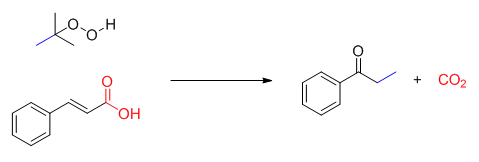| [1] (a) Goossen, L. J.; Thiel, W. R.; Rodriguez, N.; Linder, C.; Melzer, B. Adv. Synth. Catal. 2007, 349, 2241.
(b) Cornella, J.; Sanchez, C.; Banawa, D.; Larrosa, I. Chem. Commun. 2009, 7176.
(c) Lu, P. F.; Sanchez, C.; Cornella, J.; Larrosa, I. Org. Lett. 2009, 11, 5710.
[2] (a) Goossen, L. J.; Rodriguez, N.; Melzer, B.; Linder, C.; Deng, G.; Levy, L. M. J. Am. Chem. Soc. 2007, 129, 4824.
(b) Goossen, L. J.; Zimmermann, B.; Knauber, T. Angew. Chem., Int. Ed. 2008, 47, 7103.
(c) Zhou, Q. Q.; Liu, D.; Xiao, W. J.; Lu, L. Q. Acta Chim. Sinica 2017, 75, 110. (周泉泉, 刘丹, 肖文精, 陆良秋, 化学学报, 2017, 75, 110.)
(d) Yuan, J. W.; Yang, L. R.; Mao, P.; Qu, L. B. Org. Chem. Front. 2017, 4, 454.
[3] (a) Zhang, C.; Seidel, D. J. Am. Chem. Soc. 2010, 132, 1798.
(b) Bi, H. P.; Teng, Q. F.; Guan, M.; Chen, W. W.; Liang, Y. M.; Yao, X. J.; Li, C. J. J. Org. Chem. 2010, 75, 783.
(c) Lo, Vanessa, K. Y.; Wong, M. K.; Che, C. M. Org. Lett. 2008, 10, 517.
(d) Guan, B. C.; Xu, X. L.; Wang, H.; Li, X. N. Chin. J. Org. Chem. 2016, 36, 1564. (关保川, 许孝良, 王红, 李小年, 有机化学, 2016, 36, 1564.)
[4] (a) Borah, A. J.; Yan, G. B. Org. Biomol. Chem. 2015, 13, 8094.
(b) Li, Z.; Zheng, J.; Hu, W.; Li, J.; Wu, W.; Jiang, H. Org. Chem. Front. 2017, 4, 1363.
(c) Yu, J.; Mao, R.; Wang, Q.; Wu, J. Org. Chem. Front. 2017, 4, 617.
(d) Wu, Z. J.; Wang, J. Acta Chim. Sinica 2017, 75, 74. (吴自俊, 汪舰, 化学学报, 2017, 75, 74.)
(e) Li, Z.; Zheng, J.; Hu, W. G. Org. Chem. Front. 2017, 4, 1363.
[5] (a) Yin, J.; Li, Y.; Zhang, R.; Jin, K.; Duan, C. Synthesis-Structure 2014, 607.
(b) Shang, X. J.; Li, Z.; Liu, Z. Q. Tetrahedron Lett. 2015, 56, 233.
[6] (a) Telvekar, V. N.; Arote, N. D.; Herlekar, O. P. Synlett 2005, 2495.
(b) Telvekar, V. N.; Takale, B. S. Tetrahedron Lett. 2011, 52, 2394.
[7] (a) Rao, A. S.; Srinivas, P. V.; Babu, K. S.; Rao, J. M. Tetrahedron Lett. 2005, 46, 8141.
(b) Ramgopal, S.; Ramesh, K.; Chakradhar, A.; Reddy, N. M.; Rajanna, K. C. Tetrahedron Lett. 2007, 48, 4043.
(c) Rajanna, K. C.; Ramesh, K.; Ramgopal, S.; Shylaja, S.; Reddy, P. G.; Saiprakash, P. K. Green Sustainable Chem. 2011, 1, 132.
[8] (a) Rokade, B. V.; Prabhu, K. R. J. Org. Chem. 2014, 79, 8110.
(b) Guo, R.; Gui, Q.; Wang, D.; Tan, Z. Catal. Lett. 2014, 144, 1377.
[9] (a) Vinokurov, N.; Michrowska, A.; Szmigielska, A.; Drzazga, Z.; Wójciuk, G.; Demchuk, O. M.; Grela, K.; Pietrusiewicz, K. M.; Butenschön, H. Adv. Synth. Catal. 2006, 348, 931.
(b) Al-Maksoud, W.; Mesnager, J.; Jaber, F.; Pinel, C.; Djakovitch, L. J. Organomet. Chem. 2009, 694, 3222.
(c) Evano, G.; Tadiparthiand, K.; Couty, F.; Chem. Commun. 2011, 47, 179.
(d) Jouvin, K.; Coste, A.; Bayle, A.; Legrand, F.; Karthikeyan, G.; Tadiparthiand, K.; Evano, G. Organometallics 2012, 31, 7933.
[10] (a) Yang, Y.; Yao, J.; Zhang, Y. Org. Lett. 2013, 15, 3206.
(b) Yang, Y.; Chen, L.; Zhang, Z.; Zhang, Y. Org. Lett. 2011, 13, 1342.
[11] Rong, G. W.; Liu, D. F.; Lu, L. H.; Yan, H.; Zheng, Y.; Chen, J.; Mao, J. C. Tetrahedron 2014, 70, 5033.
[12] Ji, J.; Liu, P.; Sun, P. P. Chem. Commun. 2015, 51, 7546. |
